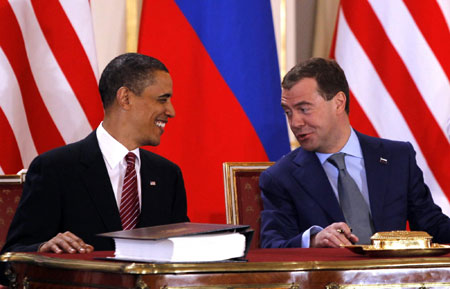Asia-Pacific
Obama and Medvedev sign disarmament treaty
(Agencies)
Updated: 2010-04-08 20:31
 |
Large Medium Small |
|
 U.S. President Barack Obama and Russian President Dmitry Medvedev smile as they sign the new Strategic Arms Reduction Treaty (START II) at Prague Castle in Prague, April 8, 2010. [Photo/Agencies] |
PRAGUE - The United States and Russia signed a landmark disarmament treaty on Thursday they hope will herald better bilateral ties and raise pressure on countries seeking nuclear weapons to renounce such ambitions.
Presidents Barack Obama and Dmitry Medvedev signed the pact at a ceremony in the mediaeval Prague Castle after talks that covered nuclear security, Iran's atomic programme and an uprising in the strategic Central Asian state of Kyrgyzstan.
The agreement will cut strategic nuclear arsenals deployed by the former Cold War foes by 30 percent within seven years but leave each with enough to destroy the other.
White House officials told reporters on Obama's flight to Prague that tougher UN sanctions against Iran's disputed nuclear programme would be prominent in his talks with Medvedev, although no specific announcements were expected.
"The Russians are already committed to holding Iran accountable through the multilateral sanctions regime," deputy National Security Adviser Ben Rhodes said.
The situation in Kyrgyzstan, where opposition protesters forced out President Kurmanbek Bakiyev on Wednesday, thrust its way on to the agenda as both Washington and Moscow have military bases in the poor Central Asian state. The US base at Manas is vital for supplying NATO forces in Afghanistan.
Obama this week announced a shift in US nuclear doctrine, pledging never to use atomic weapons against non-nuclear states, as he sought to build momentum for an April 12-13 nuclear security summit in Washington.
The US president set out his long-term goal to work towards a world without nuclear weapons in a speech at the same Prague Castle a year ago.
Medvedev said on arrival on Wednesday that the treaty could play a considerable role in shaping disarmament in the future.
White House spokesman Robert Gibbs said Obama hoped and expected the US Senate would ratify the treaty this year, before mid-term elections may change the composition of the upper house of Congress, controlled by the Democrats.











